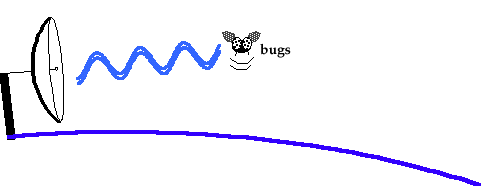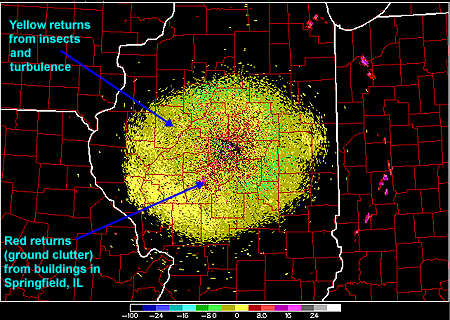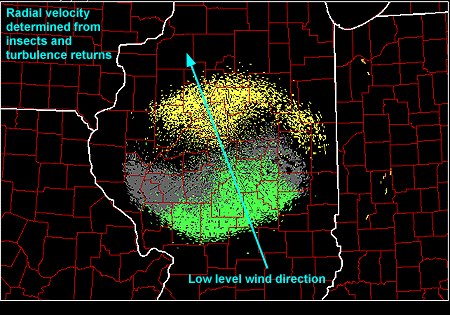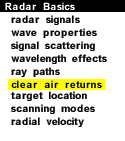
|
When a radar transmits energy, part of it may be intercepted by targets on the ground, such as buildings, trees, cars, or other objects. The return signal from these objects is called "ground clutter". Ground clutter interferes with the detection of meteorological targets, such as raindrops, because ground targets are large and typically produce high reflectivity. Ground clutter can result even if the main radar beam is above ground targets because part of the energy radiated from the antenna is emitted off the beam axis in what are known as "sidelobes". Back-scattered energy from the sidelobes is interpreted by the radar processor to come from the main lobe, so ground targets hit by one of the sidelobes appear to a radar user in the same relative position in the main lobe.
Ground clutter is usually the worst within about 20 kilometers of the radar site where the beam is still close to the earth's surface. Farther from the site, the beam is higher due to both its elevation angle and curvature of the earth away from the radar site. Ground clutter is easily identified with a Doppler radar because the radial velocity measured by the Doppler radar will approximately be zero since none of the ground targets are moving with respect to the radar. The radial velocity is not exactly zero because moving targets within the beam, such as birds, bugs, or even raindrops, also contribute to the total power return to the radar.
The Effect of Bugs:

Insects present large targets to radar and they are always present during the warmer seasons. This actually is beneficial to meteorologists. Doppler radars require targets to determine the motion of the air. Outside of regions where precipitation is falling, there would be no targets if there were no insects. Airborne insects turn out to be very good tracers of air motion since, on average, they blow along with the wind. The returns from insects allow meteorologists to see air motions outside the storm circulation which in many cases is important for predicting where new storms are likely to occur.
Turbulence provides another way in which electromagnetic energy from a radar can be back-scattered. Turbulence is associated with variations in density in the atmosphere. When variations in density occur on a scale of half the wavelength of the radar, energy is scattered through a process called diffraction. Radar echoes in a clear atmosphere will be more common on days when the lower atmosphere is unstable, as when there are thermals present, or when the wind increases rapidly with height just above the ground, so that there is mechanical turbulence.

The picture above shows the radar reflectivity measured by the National Weather Service Doppler radar at Lincoln, IL (ILX) on a beautiful clear day. Radar returns are due to insects, turbulent motions, and ground targets. These echoes, which extend out to about 100 kilometers from the radar, allow the radar operator to see the air motion.

This second picture shows the corresponding radial velocity field. The distribution of inbound (green) and outbound (yellow) velocities indicate that the low level winds are out of the south-southeast.

ray paths |
|

target location |




